The first spacecraft from Earth to visit Mars was Mariner 4 in 1965. Since then, several robotic spacecraft have flown by, orbited, or landed on Mars and sent back lots of information about this world so different from our own.
Mars is a cold, bleak wasteland, with very thin air that we Earthlings could never breathe. However, many of the pictures our telescopes, orbiters, and rovers have sent back show signs that liquid water might have been on the surface of Mars long ago. Also, we can see ice caps at the north and south poles.
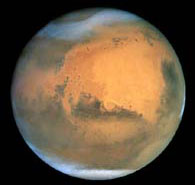
Image of Martian ice clouds. Credit: NASA/Hubble Heritage Team (STScI/AURA)
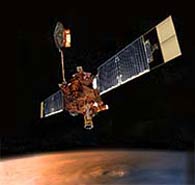
Artist's depiction of Mars Global Surveyor. Credit: NASA
All these signs of water are very exciting. Why? Because on Earth, almost everywhere there is water, there is life. Whether the water is boiling hot or frozen, some sort of creature seems to thrive in it. Is it the same on other planets? If water once flowed on Mars, did life once thrive there too? Or, maybe there is still water on Mars, only it has gone underground. Could there be tiny life forms—like bacteria—on Mars even now?

A comparison of Arizona’s Grand Canyon, left, with Mars’ Nanedi Valles, right. The images suggest that a river once cut through Nanedi Valles much like the Colorado River cuts through the Grand Canyon. Credit: NASA/JPL
NASA's four goals in exploring Mars:
Find out if life ever existed on Mars.
NASA scientists will look for water and places where living things might use heat energy from under ground. They will also look for signs of carbon, which is an element needed for life as we know it.
Learn about the climate on Mars.
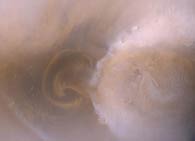
Martian dust storm. Credit: Malin Space Science Systems, MGS, JPL, NASA
Scientists who study the Martian climate will look at the melting and freezing of the polar ice caps. They'll also study the many dust storms on Mars, such as the storm shown in this image.
Learn about the geology on Mars.
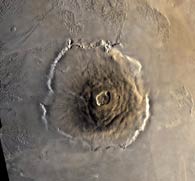
Olympus Mons. Credit: NASA/USGS
Geologists will study Martian rocks, volcanoes, craters, valleys, ridges, cracks, crannies, and other land formations to try to figure out how they were formed. The Martian volcano shown in this image, Olympus Mons, is the largest volcano in the solar system!
Prepare for humans to go to Mars!
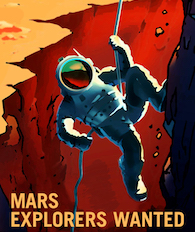
Mars explorers poster. Credit: NASA/KSC
NASA will develop technologies to help humans survive and explore the harsh Martian environment.
Mars Games:
Explore Mars!


